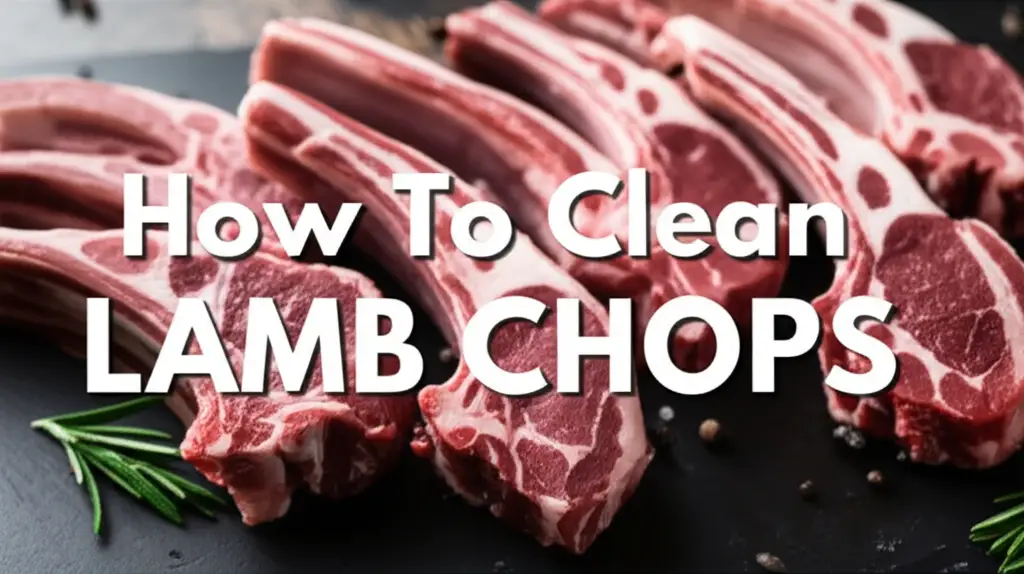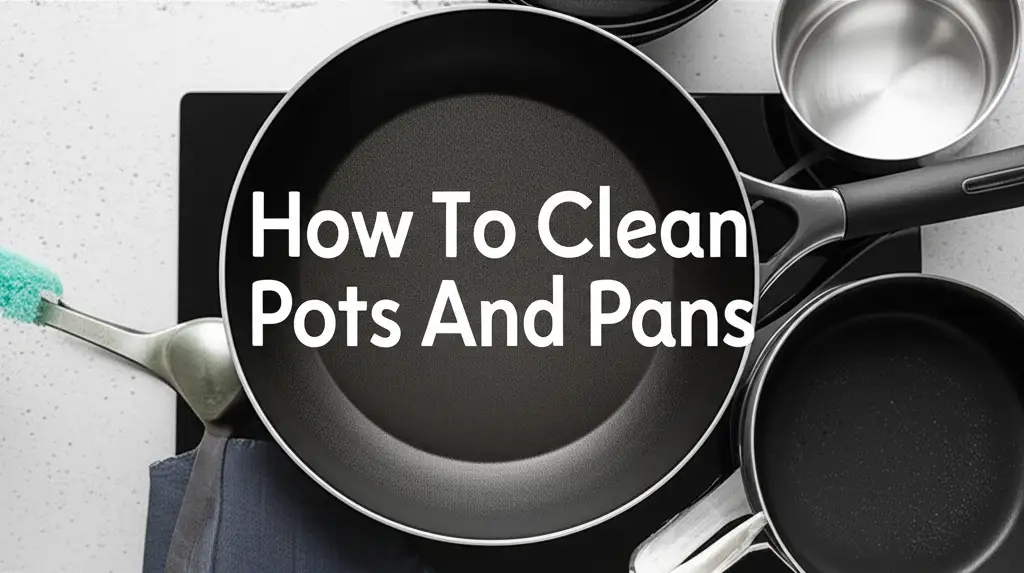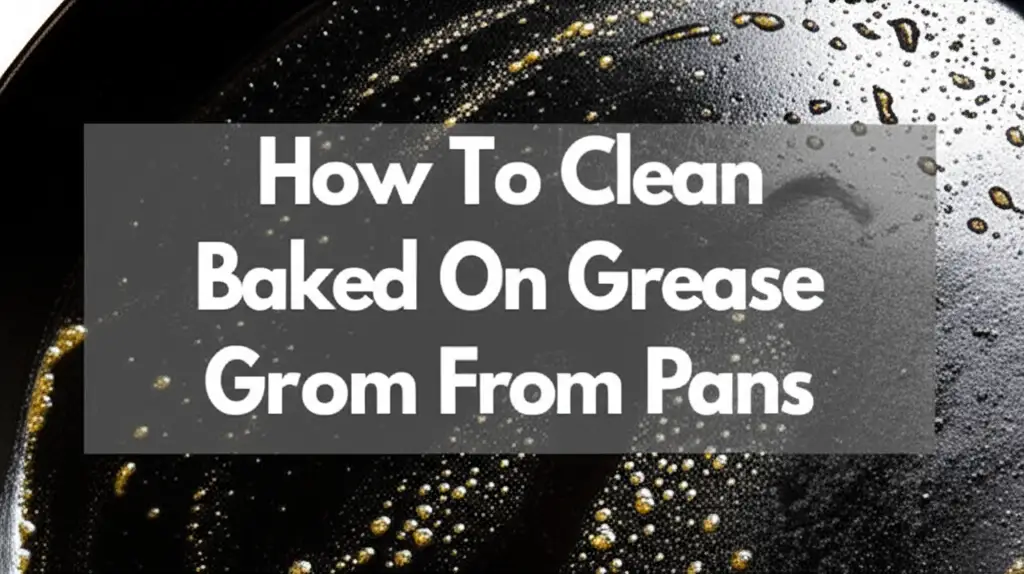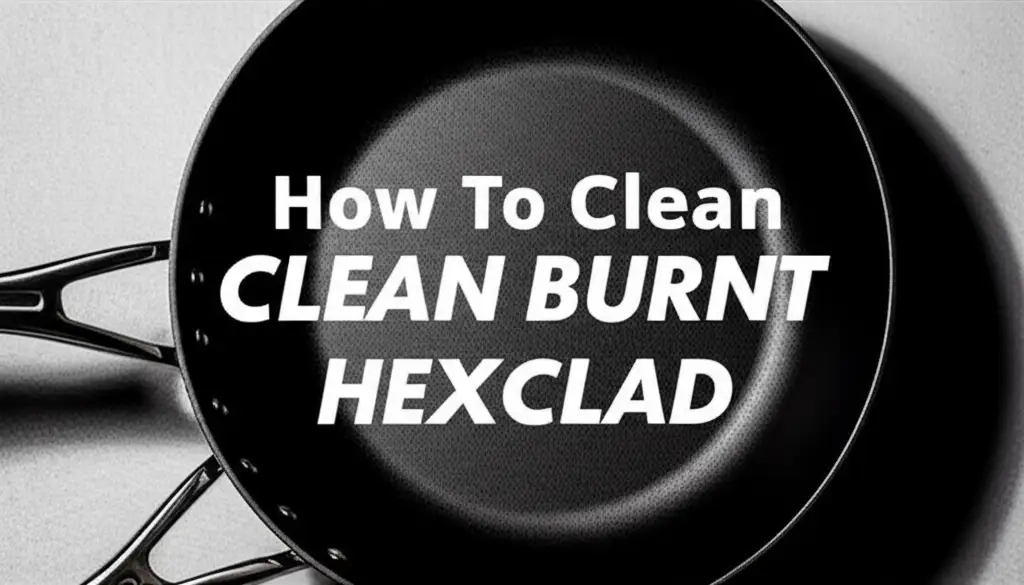· Kitchen Cleaning · 14 min read
How To Clean Bottom Of Pan
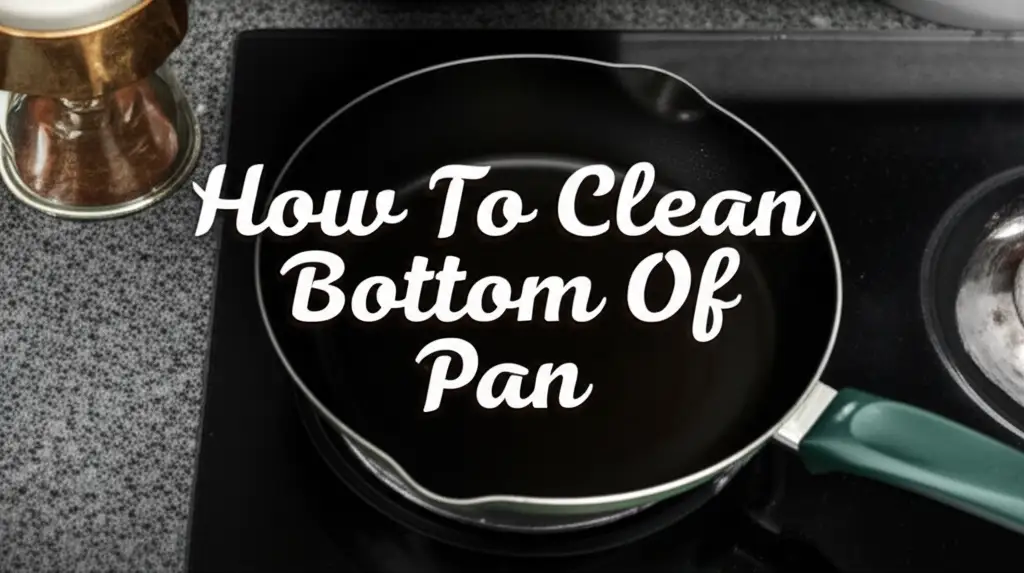
How To Clean Bottom Of Pan: Restore Your Cookware’s Shine
You love cooking, but do you love the look of your pan bottoms? Over time, even the most cherished pots and pans can accumulate unsightly grime and burnt-on residue on their exterior. This buildup makes your cookware look old and neglected. It can also affect heating efficiency. Knowing how to clean the bottom of a pan properly is a key skill for any home cook.
I understand the frustration of stubborn stains that refuse to budge. Many people just give up on dirty pan bottoms. Do not worry. Cleaning these surfaces is easier than you think. This article shows you effective methods for cleaning the bottom of your pans. We cover different materials and explain step-by-step instructions. You will learn to tackle various types of stains. We also share tips for preventing future buildup.
Takeaway:
- Use baking soda and vinegar for general pan bottom grime.
- Apply Bar Keepers Friend for stainless steel and copper pan bottom stains.
- Scrub cast iron pans gently with salt, then re-season the pan.
- Prevent buildup by wiping spills and cleaning pans after each use.
- Choose the right cleaning method based on your pan’s material.
To clean the bottom of a pan, combine baking soda with water to make a paste. Apply the paste to the stained area. Let it sit for several hours or overnight. Then, scrub vigorously with a non-abrasive pad. For tougher stains, add vinegar or a specialized cleaner like Bar Keepers Friend.
Understanding Pan Bottom Stains: Why They Happen
Pan bottoms collect dirt and grime easily. This happens for several reasons. Grease can splatter and burn onto the surface during cooking. Food often boils over, leaving sticky residues. High heat also discolors metals over time. This creates a challenging mess.
Burnt oil is a common culprit. When oil heats, it can smoke and leave a sticky film. This film hardens with repeated use. It becomes very difficult to remove. Sugary spills are another issue. If syrup or sauces spill and burn, they leave a dark, caramelized layer. These layers bond strongly to the metal. This makes cleaning tough. You can find specific ways to remove burnt oil or even how to clean burnt sugar from a pan in our other guides.
Heat discoloration is also a factor. Metals like stainless steel can change color with high heat. This often appears as blue or brown tints. This discoloration is not dirt. It is a change in the metal’s surface. Regular cleaning helps reduce its appearance. But some changes might be permanent. Understanding these causes helps you choose the right cleaning method.
Water hardness also plays a role. If you boil water and it spills, the minerals can leave deposits. These deposits combine with grease and heat. This creates complex stains. A clean pan bottom looks better. It also cooks more efficiently. A smooth, clean surface transfers heat better. It prevents hot spots. Regular cleaning extends the life of your cookware. This is why learning how to clean the bottom of a pan matters.
Essential Cleaning Supplies for Pan Bottoms
You do not need many special tools to clean pan bottoms effectively. Most supplies are already in your kitchen or laundry room. Baking soda is a versatile cleaner. It is mildly abrasive and helps lift stains. White vinegar is acidic. It dissolves grease and mineral deposits. Together, they create a powerful fizzing action. You can learn more about how they work together in our guide on how to clean with vinegar and baking soda.
Dish soap is a fundamental cleaner. It cuts through grease and helps loosen grime. For tough spots, a heavy-duty degreaser can be useful. I sometimes use a product designed for oven cleaning on very old, burnt-on layers. Always check the pan material first with strong chemicals. Oven cleaners can be harsh.
Scrubbing tools are important. A non-scratch scrubber sponge works for most jobs. For very stubborn stains, a steel wool pad might be necessary. Use steel wool with caution. It can scratch some surfaces, like non-stick exteriors. A stiff nylon brush also works well. These tools provide the friction you need to remove stuck-on grime.
You might also consider cream of tartar or lemon. Cream of tartar, mixed with water or vinegar, makes a paste. This paste is effective on some metal stains. Lemon juice offers a natural acidic cleaning option. It also leaves a fresh smell. Having these items on hand makes cleaning your pan bottoms simple. You can tackle most stains with these basic supplies.
Cleaning Stainless Steel Pan Bottoms
Stainless steel pans are durable. They often show burnt-on grease and heat discoloration on their bottoms. Cleaning these pans requires a bit of effort. But you can make them look new again. Start with baking soda and dish soap. Make a thick paste from baking soda and a little water. Add a few drops of dish soap to this paste.
Spread the paste generously over the dirty bottom of the pan. Ensure all burnt areas are covered. Let the paste sit for several hours. For very tough stains, leave it overnight. The baking soda helps lift the grime. Dish soap breaks down grease. After soaking, use a non-scratch scrubber. Scrub the entire surface in circular motions. You will see the grime start to come off. Rinse the pan thoroughly with warm water. Repeat if necessary.
For more stubborn stains, especially burnt-on oil, consider Bar Keepers Friend. This product contains oxalic acid. It is excellent for stainless steel. Wet the pan bottom. Sprinkle Bar Keepers Friend directly onto the stains. Add a little water to make a paste. Let it sit for a few minutes. Then, scrub with a wet sponge or cloth. For really set-in burnt oil, you might want to review more specific tips on how to clean burnt oil from a stainless steel pan.
If you have heat tinting, often a rainbow or blue hue, vinegar helps. Soak the pan bottom in white vinegar for 15-30 minutes. Then scrub and rinse. This method helps restore the original shine. Always dry your stainless steel pans immediately. This prevents water spots. Keeping them dry after cleaning helps maintain their appearance.
Tackling Aluminum and Copper Pan Bottoms
Aluminum and copper pans require specific care. They react differently to cleaners than stainless steel. Aluminum can darken or pit with strong acids or alkalis. Copper can tarnish quickly. Always test a small, hidden area first. This prevents damage.
For aluminum pan bottoms, a simple solution often works. Mix cream of tartar with water to form a paste. Apply the paste to the stained areas. Let it sit for 10-15 minutes. Then, scrub with a soft brush or non-abrasive sponge. Cream of tartar is mildly acidic. It helps lift discoloration without harming the aluminum. You can also boil water with lemon slices in the pan. This technique can sometimes help with exterior stains too. Rinse thoroughly after cleaning. Dry the pan immediately to prevent water spots.
Copper pans need special attention to maintain their shine. They develop a dark patina over time. You can use lemon and salt for cleaning copper pan bottoms. Cut a lemon in half. Dip the cut side into a small pile of table salt. Use this lemon half as a scrubber. Rub it directly onto the copper surface. The salt acts as a gentle abrasive. The lemon juice provides acidity. This combination works wonders on tarnish and mild burnt stains.
Another effective method for copper is a vinegar and salt paste. Mix white vinegar with a good amount of salt. Apply this paste to the pan bottom. Let it sit for a few minutes. Then scrub with a soft cloth or sponge. Rinse the pan completely with warm water. Dry it immediately to prevent new tarnish. For very deep tarnish, some commercial copper cleaners exist. Always follow product instructions carefully. Proper care keeps your aluminum and copper cookware beautiful for years.
Restoring Cast Iron and Non-Stick Exteriors
Cleaning cast iron and non-stick pan exteriors needs a gentle approach. Cast iron is durable, but its seasoning can be affected. Non-stick coatings on the outside are delicate. Using harsh abrasives can damage them. This means you need careful methods.
For cast iron pan bottoms, avoid harsh chemicals or excessive scrubbing. You do not want to remove the pan’s seasoning. If you have light grime, hot water and a stiff brush often work. For stubborn burnt areas, make a paste with coarse salt and a little water. Apply this paste to the bottom. Scrub gently with a non-abrasive sponge or a plastic scraper. The salt provides mild abrasion. It helps lift the burnt residue. After scrubbing, rinse the pan. Dry it thoroughly on the stovetop over low heat. Re-season the pan if it looks dull or patchy. This step protects the metal. You can rub a thin layer of cooking oil over the entire pan. Then, bake it in the oven. This helps maintain its non-stick properties and prevents rust.
Non-stick pans often have a coated exterior. This coating is not as robust as the interior. Harsh scrubbers like steel wool will scratch it. This can ruin the pan’s appearance. For these pan bottoms, warm, soapy water is usually enough. Fill a sink with warm water and dish soap. Let the pan soak for 15-20 minutes. This helps loosen any stuck-on grime. Then, use a soft cloth or a non-scratch sponge. Gently wipe away the dirt. For specific cleaning methods, you can check out guides like how to clean a non-stick frying pan for more details.
If you have very stubborn burnt-on spots on non-stick exteriors, try baking soda paste. Mix baking soda with water to form a paste. Apply it to the affected area. Let it sit for an hour. Then, gently wipe with a soft cloth. Do not scrub hard. This protects the non-stick coating. Rinse well and dry. Regular, gentle cleaning helps keep your non-stick pans looking good. It also ensures their longevity.
Advanced Methods for Stubborn Pan Bottom Stains
Sometimes, regular cleaning methods are not enough. Very old, baked-on grime on pan bottoms can be tough. For these extreme cases, you might need stronger solutions. These methods require caution. Always work in a well-ventilated area. Wear gloves to protect your hands.
Oven cleaner is a powerful option for severely burnt stainless steel or aluminum pan bottoms (check if the pan is oven-safe for the cleaner). Spray a thin layer of commercial oven cleaner onto the pan’s bottom. Do this outdoors or in a very open space. The fumes can be strong. Cover the pan bottom with plastic wrap. This helps keep the cleaner moist. Let it sit for several hours or overnight. The chemicals in oven cleaner break down baked-on grease. After soaking, scrape off the loosened grime with a plastic scraper. Use a non-abrasive sponge to scrub. Rinse the pan thoroughly with warm, soapy water. Ensure all cleaner residue is gone. This method is effective but should be a last resort.
Another strong cleaner is hydrogen peroxide mixed with baking soda. Make a thick paste with baking soda and hydrogen peroxide. Apply this paste to the stubborn stains. Let it sit for a few hours. The hydrogen peroxide helps lift deeply set stains. Scrub with a stiff brush or a non-scratch pad. This combination is less harsh than oven cleaner. It still offers good cleaning power.
You can also try a mixture of dish soap, baking soda, and vinegar. Combine these ingredients. Apply the mixture to the pan bottom. Let it bubble and work on the grime for at least 30 minutes. Then, use a strong scrubbing pad. This method is effective for various types of pan materials. Remember to always rinse your pans completely after using any strong cleaning agent. This removes chemical residues. Strong cleaners can damage some pan finishes. Always check your pan’s material and manufacturer’s instructions before using them.
Preventive Measures to Keep Pan Bottoms Clean
Keeping your pan bottoms clean is easier than removing old, baked-on stains. Regular maintenance saves you time and effort. Develop good habits in the kitchen. This will keep your cookware looking its best.
One simple tip is to wipe spills immediately. If food or oil boils over, clean it up right away. Do not let it bake onto the pan bottom. A damp cloth can often remove fresh spills easily. This prevents them from becoming hard, burnt-on spots. I make sure to do this right after cooking. This small step makes a big difference.
Clean your pans after every use. Do not just focus on the cooking surface. Take a moment to scrub the bottom too. Use hot, soapy water and a regular sponge. This removes any light grease or residue that might have accumulated. This daily habit prevents major buildup. If you have a busy kitchen, it might seem like an extra step. But it saves you from future deep cleaning sessions.
Consider using a splatter guard when cooking with oil. Splatter guards reduce oil splashes. This means less grease lands on the bottom and sides of your pans. They are inexpensive tools. They help keep your stovetop and pans cleaner. You will spend less time scrubbing.
Adjust your heat settings. Cooking at excessively high temperatures can cause food to burn more easily. This increases the chance of spills and burnt residue on pan bottoms. Use medium heat when possible. This often provides enough cooking power without extreme scorching. Proper heat management also helps your food cook evenly. By following these simple preventive steps, you can maintain shiny, clean pan bottoms with minimal effort. This extends the life of your cookware. It also keeps your kitchen looking good.
FAQ Section
Q1: Can I use oven cleaner on all types of pan bottoms? A1: No, you cannot use oven cleaner on all pan types. It is suitable for stainless steel and some heavy-duty aluminum pans. Never use it on cast iron, non-stick coatings, or anodized aluminum. Always check the pan material first. Test a small, hidden spot to avoid damage. Oven cleaner is a harsh chemical.
Q2: How often should I deep clean my pan bottoms? A2: Deep cleaning frequency depends on your cooking habits. If you cook often and have noticeable buildup, deep clean every few weeks or months. For light use, once every six months might suffice. Regular light cleaning after each use helps reduce the need for frequent deep cleaning.
Q3: What is the best method for removing burnt oil from a pan bottom? A3: For burnt oil, a baking soda paste is very effective. Mix baking soda with a little water to form a thick paste. Apply it to the burnt oil. Let it sit for several hours or overnight. Then scrub with a non-abrasive pad. For tougher stains, use Bar Keepers Friend on stainless steel.
Q4: Is it safe to use steel wool on pan bottoms? A4: Use steel wool with caution. It is safe for stainless steel and heavily seasoned cast iron. Never use it on non-stick coatings, anodized aluminum, or highly polished copper. Steel wool can cause scratches and remove protective layers. Always choose a scrubber appropriate for your pan material.
Q5: How can I prevent pan bottoms from getting dirty in the first place? A5: Preventative measures are key. Wipe spills immediately during cooking. Clean pan bottoms with warm, soapy water after every use. Use appropriate heat settings to prevent scorching. Consider a splatter guard to minimize oil splashes. These steps reduce future buildup.
Q6: Does cleaning pan bottoms affect cooking performance? A6: Yes, a clean pan bottom can improve cooking performance. Burnt-on grime acts as an insulator. This prevents even heat distribution. A clean, smooth pan bottom transfers heat more efficiently. This leads to more consistent cooking results and can save energy.
Conclusion
Keeping your pan bottoms clean is more than just aesthetics; it improves cooking efficiency and extends the life of your valuable cookware. We explored several effective methods for how to clean the bottom of a pan, from simple baking soda and vinegar pastes to stronger solutions for stubborn grime. Remember to choose the right method for your specific pan material, whether it is stainless steel, aluminum, copper, or cast iron.
By incorporating regular cleaning habits and preventive measures, you can avoid the frustrating buildup of baked-on grease and discoloration. Take the time to wipe spills immediately. Make sure to clean the exterior of your pans after each use. These small efforts make a big difference. Your cookware will shine brightly. It will also perform better in the kitchen. Start today. Enjoy the satisfaction of clean, efficient pots and pans.
- pan cleaning
- burnt pan
- cookware cleaning
- grease removal
- kitchen tips

